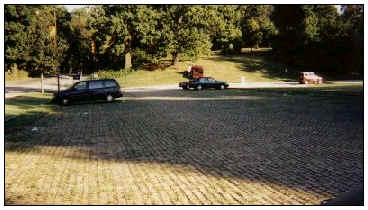
|

|
To Print Use The pdf File
ILLINOIS URBAN MANUAL
PRACTICE STANDARD
PERMEABLE PAVEMENT
(sq ft)
CODE 890
 (Source: Center for Watershed Protection) |
DEFINITION
A pavement consisting of structural materials (e.g., concrete slabs, paving blocks or grids, or turf blocks) having regularly interspersed void areas. The voids are filled with pervious materials, such as vegetated soil, gravel or sand.
PURPOSE
The purpose of this practice is to reduce runoff
and associated pollutants from low-volume traffic areas by providing a load
bearing surface having adequate strength to accommodate vehicles while allowing
infiltration of surface water and filtration of pollutants. This is accomplished
by trapping a portion of rainfall in the pavement's voids and infiltrating it
into the underlying soil.
CONDITIONS WHERE PRACTICE APPLIES
This practice applies where pavement is desirable or required for low-volume traffic areas.
This practice should be used with caution in areas underlain with highly permeable soils (i.e., surface sand or gravel) where infiltrated pollutants may reach groundwater without opportunity for attenuation.
The effects of subgrade compaction, freeze-thaw cycles and deicing and snow removal must be considered in determining the applicability of this practice.
Possible areas for use of these paving materials include:
1. Parking lots, especially fringe or overflow parking areas
2. Parking aprons, taxiways, blast pads, and runway shoulders at airports (heavier loads may demand use of reinforced grid systems)
3. Emergency stopping and parking lanes and vehicle cross-overs on divided highways
4. Off-street parking aprons in residential neighborhoods
5. Recreational vehicle camping area parking pads
6. Private roads, easement service roads, and fire lanes
7. Industrial storage yards and loading zones (heavier loads may demand use of reinforced grid systems)
8. Driveways for residential and light commercial use
9. Bike paths, walkways, patios, and swimming pool aprons
10. As an alternative to conventional paving in areas where tree protection and preservation is a concern
CRITERIA
Permeable pavement can infiltrate up to the first half inch of precipitation. Provisions must be made to handle the runoff from larger storms.
Permeable pavement system categories include:
1. Cast-in-place concrete slabs: Reinforced concrete slabs covering large areas are formed in place on the ground to be covered. The slab is suitable for heavy loads and has maximum resistance to movement caused by frost heave or settling.
2. Pre-cast concrete grids: Concrete paving units incorporating void areas, usually pre-cast in a concrete products plant and trucked to a job site for placement. These units have a higher percentage of permeable (i.e., grass) surface.
3. Modular unit pavers: Smaller pavers which may be clay bricks, granite sets or pre-cast concrete of various shapes. These pavers are monolithic units which do not have void areas incorporated in the blocks. They are installed on the base layer with pervious material placed in the gaps between units.
4. Geowebs: Although geowebs are primarily designed for soil reinforcement, they may be applicable as a permeable pavement.
The manufacturer’s specifications shall be used to determine if the material to be used is suited for the intended purpose and for the gradation of the base course. The base course of granular material shall be at least 6 inches thick. Filter fabric shall be required between the compacted ground surface and the base course. The filter fabric shall meet the requirements of material specification 592 GEOTEXTILE Table 1 or 2, class I, II, or IV with AOS of 30 for woven and 50 for nonwoven.
CONSIDERATIONS
For stormwater quality as well as aesthetic purposes, it is recommended that the void areas in permeable pavement be filled with soil and planted with grass. Vegetation can improve infiltration and the physical filtering of runoff as well as reduce water volumes through long-term transpiration.
For parking lot applications, since permeable pavement with turf does not hold up well under frequent traffic, it is suggested to use permeable pavement only in the parking spaces and pave the traffic lanes in the normal fashion.
The runoff reduction effectiveness of permeable pavement is largely a function of the relative size of the openings in the pavement. Blocks with large openings, sometimes called turf blocks, are recommended. Conventional modular pavers that are grouted in place generally will not be very effective.
In areas where tree protection and preservation applies the protection of trees shall meet the requirements of practice standard Tree Protection 990.
PLANS AND SPECIFICATIONS
Plans and specifications for installing permeable pavement shall be in keeping with this standard and shall describe the requirements for applying the practice to achieve its intended purpose. At a minimum include the following:
1. Pavement location.
2. Paver thickness and type.
3. Base course thickness and gradation.
4. Filter fabric requirements.
5. Void material and dimensions.
6. Seeding requirements.
All plans shall include installation, inspection, and maintenance schedules with the responsible party identified.
OPERATION AND MAINTENANCE
Where turf is incorporated into these installations as the permeable surface medium, some turf maintenance will be necessary. However, fertilizers and deicing chemicals have adverse effects on concrete products in general, and the use of such chemicals should be restricted as much as possible. Deicing chemicals also adversely affect turf. Mowing is seldom required in areas of frequent traffic.
Cast-in-place installations, because they are monolithic and maintain a smooth surface, can be snow plowed provided the blade is set high enough to prevent damage to grass cover. Additional care is needed in plowing paving blocks or grids.
NRCS IL January 1999